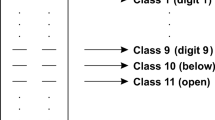Abstract
People who cannot walk by themselves need someone to carry them around on a wheelchair. A voice recognition system was developed to recognize a set of commands used by people with disability to control their wheelchair and devices around them. Voice samples of various commands from 8 different speakers were collected. The features of the collected samples were extracted using MFCC feature extraction technique. The MFCC (Mel-frequency cepstral coefficient) feature extraction technique involves pre-emphasis, framing, windowing, FFT, Mel-scale transformation operations. The major reason for choosing MFCC extraction is that the human ear has a response of a logarithmic scale and not a linear scale. Hence, all the framed voice samples are transformed to the Mel-scale with a logarithmic response and stored in the form of K-means clusters. Features extracted from test data are applied to the models developed for commands, and based on the minimum distance criterion, the model is selected to be closely associated with the respective voice command. The voice recognition system was developed for an 8-command model using MATLAB.

Similar content being viewed by others
Change history
28 September 2023
A Correction to this paper has been published: https://doi.org/10.1007/s42979-023-02168-3
References
Rabiner L, Juang B-H. Fundamentals of speech recognition. New Delhi, India: Pearson Education (Singapore) Pte. Ltd.; 1993.
Yu D, Deng L. Automatic speech recognition: a deep learning approach. London: Springer; 2015.
Pandey D, Singh KK. Implementation of DTW algorithm for voice recognition using VHDL. In: International conference on inventive systems and control ICISC, 2017.
Saini P, Kaur P. Automatic speech recognition: a review. Int J Eng Trends Technol. 2013;4(2):132–6.
Kumar ANA, Muthukumaraswamy SA. Text dependent voice recognition system using MFCC and VQ for security applications. In: International conference on electronics, communication and aerospace technology, ICECA, 2017.
Prerana D, Kakali A, Pranab D, Vijay P. Voice recognition system: speech-to-text. J Appl Fundam Sci. 2015;1:191–5.
Basanta H, Huang Y-P, Lee T-T. Assistive design for elderly living ambient using voice ad gesture recognition system. In: IEEE international conference on systems man and cybernetics, ICSMC, Canada, 2017.
Al Smadi T, Al Issa HA, Trad E, Al Smadi KA. Artificial intelligence for speech recognition based on neural networks. J Signal Inf Process. 2015;6(2):66–72.
Revathi A, Jeyalakshmi C, Muruganantham T. Perceptual features based rapid and robust language identification system for various Indian classical languages. In: International conference on communication and electronics systems, ICCES, 2017.
Clayton RL, Winter DLS. Speech data entry results of a test of voice recognition for survey data collection. J Off Stat Stockh. 1992;8(3):377.
Author information
Authors and Affiliations
Corresponding author
Additional information
Publisher's Note
Springer Nature remains neutral with regard to jurisdictional claims in published maps and institutional affiliations.
This article is part of the topical collection “Advances in Computational Intelligence, Paradigms and Applications” guest edited by Young Lee and S. Meenakshi Sundaram.
Rights and permissions
Springer Nature or its licensor (e.g. a society or other partner) holds exclusive rights to this article under a publishing agreement with the author(s) or other rightsholder(s); author self-archiving of the accepted manuscript version of this article is solely governed by the terms of such publishing agreement and applicable law.




